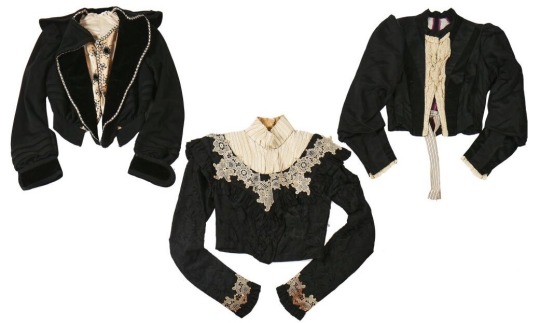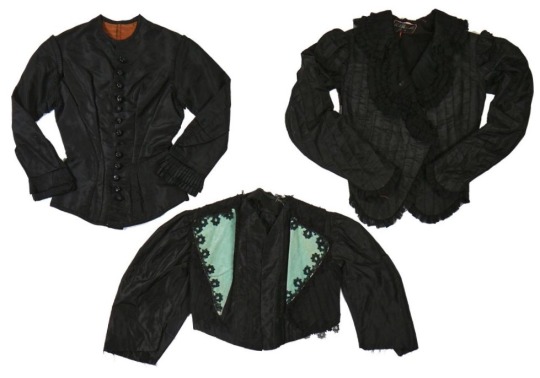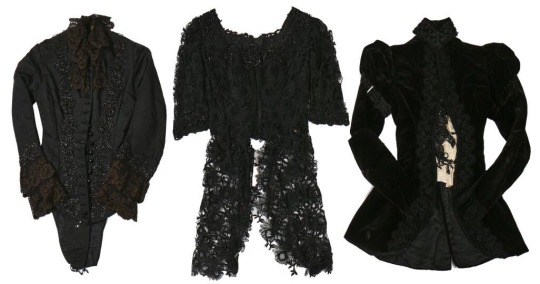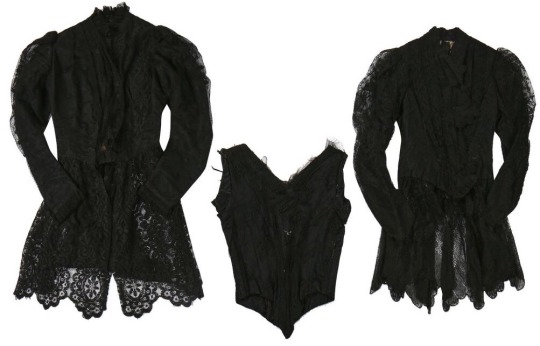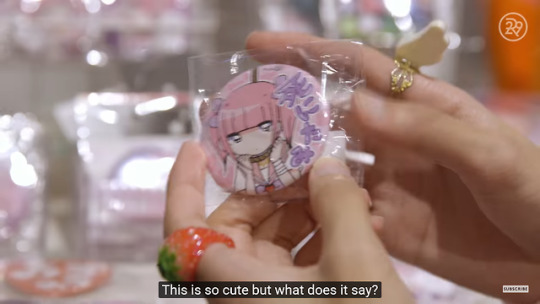◼️Irina, F21 ◼️She/her, medical student, artist and psychopath ◼️ Russian/Ukrainian/English
Don't wanna be here? Send us removal request.
Text
things to put in a journal/letter/etc.
✧ scraps of fabric
✧ poetry
✧ comic strips and magazine/newspaper cut outs
✧ small, handwritten notes in the shape of a heart
✧ ribbon
✧ rocks
✧ bandaids with nice sayings written on them
✧ small origami, like a crane
✧ puzzle pieces
✧ buttons
✧ cards from games
✧ sea shells
✧ shark teeth
✧ small jewelry
✧ paperclips
✧ recipe cards
✧ cutouts from boxes
✧ vintage postcards
✧ photos
✧ stamps
✧ lists of anything you’d like
✧ bottle caps
✧ qr code with a video or song
✧ stickers
✧ drawings, doodles, and sketches (!!)
✧ stationary
✧ hair pins
✧ safety pins with beads attached
1K notes
·
View notes
Text
Chrome extensions I actually use as a mentally ill university student
Making websites easier to digest:
Dark Reader - Changes any webpage to dark mode.
Mercury Reader - Simplifies the layout of any webpage to eliminate distractions and irritating formatting.
Podcastle AI - Turns any article into a podcast. This is a lifesaver for being able to process what I’m reading, to be honest.
Spelling/grammar:
LanguageTool - Spelling and grammar check for those of us who regularly type in more than one language.
Grammarly - Spelling and grammar check for those of us who only type in English. Can be used with LanguageTool installed, which is what I do.
Google Dictionary - Define any word on the webpage with a double-click.
Google Translate - Translate an entire webpage or even just a short segment.
Misc:
AdGuard Adblocker - After trying quite a few adblocker options, this is the one I find the best.
The Great Suspender - Automatically suspend inactive tabs to help with performance.
Honey - Try coupon codes automatically to save money on online purchases.
Built-in Chrome tab grouping - Group your tabs to keep organized and minimize distracting clutter.
26K notes
·
View notes
Photo


If you liked that enviable Victorian sword perfume bottle I posted a few years ago, you’ll LOVE this late Victorian miniature sword. Like the perfume bottle, this is also fitted to hang on a chatelaine, and would have been used as a letter opener. Sold by The Eden Collective.
13K notes
·
View notes
Text
Victorian and Edwardian actresses are just… girl. give me the number of whoever the FUCK designed that outfit. like damn. I try so hard but i cannot compare to Minnie Tittell Fucking Brune (pictured) or Lily Elsie or anybody and it hurts so bad
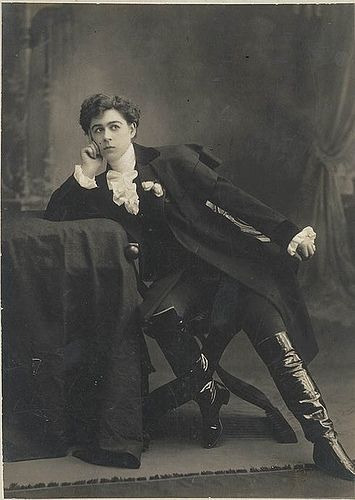
26 notes
·
View notes
Text
Victorian Money Means Coins – Research Behind Steampunk (Custard Protocol Special Extras)
This is one of those blog posts in which I demonstrate the nitty-gritty of research in an aggravatingly nit-picky way.
This is an amended reboot from 2012 when I first started writing Prudence.
Read at your own risk.

To protect the guilty I’m not going to name any names, Gentle Reader, and I’d like to state up front that currency is not my expertise.
However, I was reading a book of the alt-historical romantic variety. The hero visits a whore in Victorian London, 1883.
For her pains he “pulled out far more notes than planned and handed them to her.”
I had to put the book down.
It was very upsetting.
Coins vs. Notes in Victorian England
BANK NOTES!
First, bank notes are drawn on a bank more like a cashier’s check (or an IOU) than paper money today, which means the whore in our above example would have to go into a bank to redeem her notes or find herself a very non-suspicious tradesman, in modern times this is a little like trying to break a $1000 bill.
ON YOUR PERSON?
Second, no one regularly carried notes or paid for anything with notes until well after the 1920s. Culturally, no one would carry that much money into the kind of area of London where whore houses are located.
For services people paid with coin, with tradesmen (who handle goods) the wealthy actually paid via their butler or valet or abigail’s coin, or on account, because it was beneath them to physically touch money.
Even, as the author was trying to get across, this was a highly generous gesture, NOT WITH PAPER MONEY HE WOULDN’T.
*HEAVY BREATHING*
We writers all make mistakes. I have made more than my share. And there comes a time when every historical author must stop researching and begin writing (or the book never gets written).
I do understand and believe that some modernization is necessary in alt-history genre fiction because most readers want their books to be fun and entertaining. It is our business, as authors, to provide that first. (Now for genres like historical fiction or biographies this is a different matter. I am speaking in terms of managing expectations.)
BUT IT’S MONEY
However, I do think something as basic as currency should be second knowledge if you are going to write in any alternate time period. It’s like getting the basic clothing terms correct. (In another unnamed steampunk novel, a corset was referred to as a bodice. FYI, both terms are incorrect. At the time, a corset would have been mainly referred to as stays. The bodice is the top part of a dress. Thus, I spent the entire scene confused into thinking the character in question was swanning around with only her torso dressed, rather than entirely in her underthings as was intended. But, I digress …)
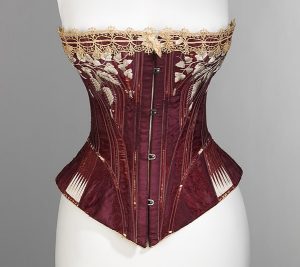
A corset AKA stays
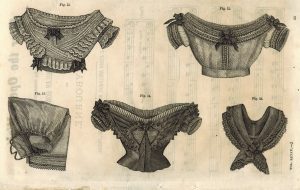
Godeys July 1872 Bodices
On Victorian Money (from Baedecker’s London 1896)
sovereign or pound (gold) = 20 shillings
half-sovereign (gold) = 10 shillings
crown (silver) = 5 shillings
half-crown (silver) = (2 shillings & a six penny piece)
double florin (silver – rare) = 4 shillings
florin (silver) = 2 shillings
shilling (silver & same size as a sovereign) = 12 pennies
six penny (silver) = 6 pennies
three penny (silver) = 3 pennies
penny (bronze) = 4 farthings
half penny = 2 farthings
farthing
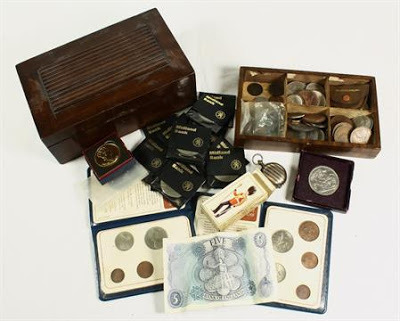
From lot at auction.
I know, I know, overly complicated. Think back to that wonderful scene with the money exchange in Room With a View when Cousin Charlotte comes to visit Lucy’s family.

source pinterest
“In England alone of the more important states of Europe the currency is arranged without reference to the decimal system.” ~ Karl Baedeker, 1896
Victorian Money in Terms of Value
In 1896: 1 sovereign was approximately: 5 American dollars, 25 francs, 20 German marks, or 10 Austrian florins.
To reiterate: The Bank of England issued notes for 5, 10, 20, 50, and 100 pounds or more. They were generally not used in ordinary life as most people “dealt in coin.” Gentlemen and ladies, when shopping, either had a servant with them to handle the coin (including gratuities & all fares) or paid on credit (AKA account). A shop would then send a bill around to the townhouse at the end of the month on Black Monday, which would be paid by the house steward, accountant, or personal secretary. A gentleman handling his own money is either no gentleman or engaged in nefarious activities like gambling or trade.
Baedeker advises letters of credit (AKA circular notes) drawn on a major bank for travel, to be exchanged for local currency upon arrival. He also advises never carrying a full days worth of coinage about your person.
It’s important, as historical writers, for us to grasp a larger picture – so allow me to attempt to put this into perspective…
Middle class wages per annum 1850-1890:
A Bank of England Clerk £75 to £500
Civil Service clerk £80 to £200
Post Office clerk £90 to £260
Senior Post Office clerk £350 to £500
So let’s say a middle class wage was anything from £75 to £500 a year, that’s £1.44 – £9.61 a week for a relatively comfortable lifestyle.
Since there is no £1 note, to “pull out far more notes than planned” as our unnamed author writes above, and give such to a whore, means at least £5 per note. More than one means at least £10. Not only should this character not have been carrying that kind of money, he just tipped that woman better than one week’s salary for the upper middle class to someone who likely could never break that bill, today that’s something on the order of $2,500.
A gentleman of lower standing, say a younger son with a Living could expect something similar to upper middle class £350-500.
Titled or large landed gentry could pull in anything from £1000 to £10,000 a year (what, you thought the 99% was a new thing?).
A dowry for landed country gentry’s daughter of few means would be about £100 a year.
Still, even the highest aristocrat wouldn’t tip in notes, ever. If for no other reason than it’s the kind of thing the neuvo riche, or An American might do. (It’s worth noting that poor were a great deal poorer, earning shillings per week or less.)
Later on, this same author writes “cost me twenty quid to delay matters” of bribing a coroner to delay a funeral. That’s a heavy bribe, about $5000. I couldn’t find any information on coroner’s pay in Victorian times (the job was either uncommon, not yet official, or went by another name) so let’s say grave digger, which is well below middle class, so a £20 bribe would probably be about a year’s income for the man.
End of Rant
A Budget from 19th Century Historical Tidbits
Sorry, I just had to get that off my chest. Or should I say “out of my chest”? Chink chink.
So, if you have a Victorian setting (really, anything up through the 1920s) what do we pay with?
Yes, that’s right children, coins!
This is also a rather depressingly clear indication of how Gail Carriger spends her weekends. I am such a dork.
“I may be a chump, but it’s my boast that I don’t owe a penny to a single soul – not counting tradesmen, of course.”
~ Carry On, Jeeves by P.G. Wodehouse
As always, you don’t have to take my word for it. Earlier in time, but still relevant podcast…
More or Less Behind the Stats: How Rich was Jane Austen’s Mr Darcy?
How does this relate to Prudence?
Well might you ask. What I had to do (or thought I had to do) was determine the conversion rate between pounds and rupees traveling from England to India in 1895.
Unfortunately, Baedecker didn’t write for India.
What I ended up having to do was make some very loose estimations based on the above assumptions of middle class wages and the information I could source, which was monthly accounts for a household of four living in India on a diplomat’s wage between 1880 and 1897 (something on the order of £500 per annum). Here’s my fun chart:

Here’s hoping the above was, if not fun, at least informative or, if you yourself are an author, helpful.
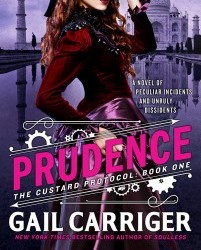
Prudence by Gail Carriger
Pip pip!
723 notes
·
View notes
Text
Victorian Dress For Every Occasion - 1890s Edition
The Victorian period was much about appearances and very specific etiquette, especially when it came to clothing. They had dressing etiquette for literally every activity during the day and people changed their outfit many times a day, especially in upper class circles. It honestly gets very convoluted so I decided to look into it more deeply. Not understanding the dress etiquette of the times creates a lot of weird costumes in period drama for example, where a dress might have elements of real extent garments, but they are combined in ways that would make no sense to Victorians.
To limit this post and my research I’m looking into 1890s. I also think it gives better idea about the differences between the outfits if they are all from the same decade. I’ll also limit myself to upper class and women’s clothing. I think it would be interesting to look at men’s dress etiquette and etiquette of the lower classes, but alas it has to be another post.
The broad strokes are that from the turn of the 19th century to WW1 during the day you would wear long sleeves and little to no cleavage and in the evening you could show more skin, except when dining. The specifics shifted from time and place.
Nightgown

Nightgown, as you might guess, was worn for sleeping. They started as basically shifts, the very basic under dress worn next to skin, but during the Victorian Era they became increasingly elaborate and when 1890s was reached they were profoundly extra. You would never show yourself in your nightgown alone. For them it was probably pretty much the same as wearing only your underwear. Even in your bedroom or dressing room you would cover it up, which leads us to…
Dressing Gown
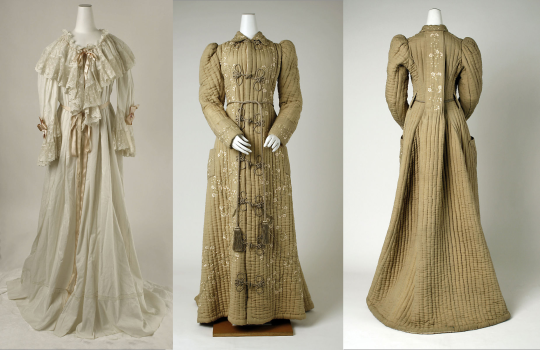
Dressing gown was exactly what was used to cover nightgown. In some sources I’ve seen this called wrapper. But basically it was a glorified bathrobe. It was not used outside your own private chambers, but inside them while you got ready for the day. It was usually long and loose comfortable robe, often tied by waist with a cord. During summer they were light and in winter they might have been woolen or from quilted fabric for warmth. They were heavily inspired from especially Japanese kimono as Orientalism was very in in Europe during 19th century. Under it a ribbon corset or morning corset could be used, but that was not necessary. Ribbon corset was made entirely of thick ribbons and ended under the bust, with only couple of bones to keep it in shape, and morning corset doesn’t have cording and instead is just wrapped around the torso. They were made for comfort and bust support and didn’t shape heavily or reduce waist.
Wrapper

Wrapper or morning dress was used during the morning in the comfort of home. The terminology around this type of clothing is murky and they had a lot of overlap with tea gown and dressing gown. Some primary sources described wrapper as something you can wear on top of a dress to keep the dress clean and others as plainer and looser version of the day dress. Most extent garments, I found from 1890s, were the latter type. The former sounds something that could be used as a dressing gown too, which would explain, why the dressing gown was called wrapper in some sources. What I have gathered, is that earlier in Victorian era wrapper meant something similar to dressing gown, but maybe more presentable or dress-like, worn over a morning dress of just the undergarments. I think by the 1890s the whole outfit worn in morning had begun to be referred as wrapper, since I had a hard time finding morning dresses dated to 1890s. Regardless of the terminology, in 1890s wrapper was used in home outside personal chambers. It was acceptable to receive early visitors in it, but it was very informal and mostly reserved for very close people. It was plain and practical, but when it comes to rich people it became increasingly elaborate during Victorian era. It’s a theme here. It was often loose, but it could be more or less structured (often less). Under it you would usually wear all the typical undergarment layers (combinations or shift with drawers, corset, corset cover and petticoat), though morning or ribbon corset could be worn instead of the normal one.
Tea gown
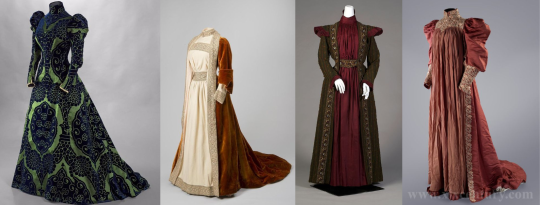
Tea gowns started as house dress, basically an open presentable wrapper worn over a fancier petticoat or morning dress, but by the 1890s it became somewhat of a statement piece. At first it was seen as tacky to be too dressed up in your own home, even when receiving guests, but I think we have established that 1890s Victorians were very, very extra. Tea gowns were worn for receiving house guests during the day and in the late Victorian era, as tea gowns had become so extravagant, they were also used in the evening for receiving casual gatherings of close friends or family. Similar to wrappers, they were looser than clothing worn outside, but could be structured or lack any structuring at all. Except they were made from more expensive materials and had much more detailing. They also often had drains and a real or fake open robe-like thing, which I assume was a nod to house dresses. All the undergarments were worn under it, but morning or ribbon corset could be used under it, if very close friends were visiting. Very loose tea gowns (like the pink one on the right) were inspired from the Victorian counter culture fashion movement, Aesthetic movement, which rejected the rigid Victorian silhouette.
Day dress

Day dress or afternoon dress was formal and elaborate, as it was used outside of home and meant to be seen. Unlike the gowns reserved for home usage, it was generally made from two pieces, bodice and skirt. But of course, you would always wear matching pieces. It had long sleeves and high neckline. As the name reveals, it was worn during daytime. It could be worn for visiting and then, especially when visiting close friends or relatives, it could have slightly shorter sleeves or lower neckline, but not as low as with evening wear. It was also worn for promenading outside. When used for carriage rides train was acceptable, when for walks, shorter one was seen as preferable, but as we know Victorians were extra and sometimes still wore a train. Since weddings were (and are) held during the day, a day dress was used for that too. The finest day dress was used of course and after queen Victoria’s wedding white became the most popular color. People who weren’t rich, might have still opted out from it, as pure white dress was very expensive.
Walking dress
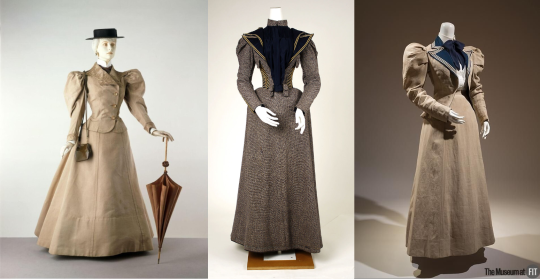
Walking dress was, you guessed, used for walking. Victorians were really into city walks and would use a walking dress for looking around in cities. It was a type of day dress but much more practical and less elaborate. It was usually made from sturdier materials and the skirt was short enough to reveal shoes. It often had a skirt, blouse and a coat, sometimes a waistcoat too. Because of it’s practicality, it was often used for travelling too.
Dinner dress
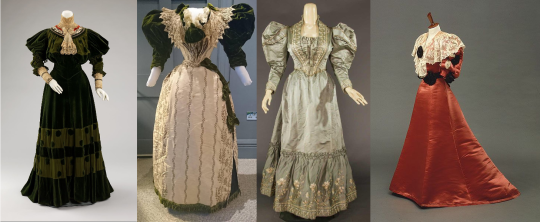
Dinner dress was used in evening, but unlike other evening dresses, more skin coverage was appropriate. Sleeves could be as short as elbow length and neckline could be more open than with day dress. As the name suggests, it was used for dining and dinner parties.
Evening dress
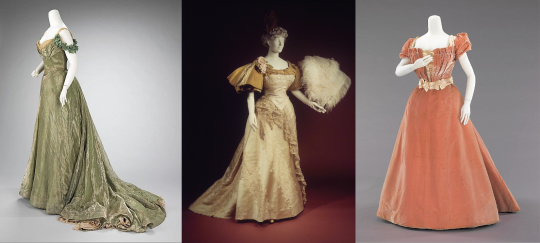
Evening dress was the fanciest of them all and the most official. It had short sleeves or only straps (in the middle of the decade huge sleeves very very fashionable) and low and wide neckline. It was used in fancy evening occasions when presenting yourself for the high society. Balls were of course the main events of high society, there every one would put on the best they had, there was no holding back. For opera people also dressed to be seen and would dress up, but for theater a little toned down look was more appropriate.
It was very common to have bodices for different occasions (day/evening/dinner) made for the same skirt, so same material and style, but different sleeve lengths and necklines. Clothing were very expensive and the skirt had the biggest amount of fabric making it the most expensive part, so it was very economical to use the same skirt for different occasions.
3K notes
·
View notes
Photo





Color Me Blood Red (Herschell Gordon Lewis, 1965)
842 notes
·
View notes
Text
Chrome extensions I actually use as a mentally ill university student
Making websites easier to digest:
Dark Reader - Changes any webpage to dark mode.
Mercury Reader - Simplifies the layout of any webpage to eliminate distractions and irritating formatting.
Podcastle AI - Turns any article into a podcast. This is a lifesaver for being able to process what I’m reading, to be honest.
Spelling/grammar:
LanguageTool - Spelling and grammar check for those of us who regularly type in more than one language.
Grammarly - Spelling and grammar check for those of us who only type in English. Can be used with LanguageTool installed, which is what I do.
Google Dictionary - Define any word on the webpage with a double-click.
Google Translate - Translate an entire webpage or even just a short segment.
Misc:
AdGuard Adblocker - After trying quite a few adblocker options, this is the one I find the best.
The Great Suspender - Automatically suspend inactive tabs to help with performance.
Honey - Try coupon codes automatically to save money on online purchases.
Built-in Chrome tab grouping - Group your tabs to keep organized and minimize distracting clutter.
26K notes
·
View notes
Text
Beautiful Latin phrases ~ part 3
•omnia iam fient quae posse negabam - everything which I used to say could not happen, will happen now
•poeta nascitur, non fit - the poet is born, not made
•qui dedit benificium taceat; narrat qui accepit - let him who has done a good deed be silent; let him who has received it tell it
•saepe ne utile quidem est scire quid futurum sit - often, it is not advantageous to know what will be
•sedit qui timuit ne non succederet - he who feared he would not succeed sat still
•si vis pacem, para bellum - if you want peace, prepare for war
•struit insidias lacrimis cum feminia plorat - when a woman weeps, she is setting traps with her tears
•sub rosa - under the rose
•trahimir omnes laudis studio - we are led on by our eagerness for praise
•urbem latericium invenit, marmoream reliquit - he found the city a city of bricks; he left it a city of marble
•ut incepit fidelis sic permanet - as loyal as she began, so she remains.
762 notes
·
View notes
Text
PSYCHODOC'S DАY №1
Цель: переключиться в другой образ и почувствовать что-то новое.
Задачи: выполнить необходимое домашнее задание из университета/колледжа/школы, практиковать язык, создать комфортную обстановку.
Утро доброе, когда встаёшь рано и делаешь чай перед уборкой; обновляешь цвет волос краской или тоникой; садишься делать задания под музыку; макияж и образ даже дома для поддержания рабочего настроения; минимум еды, только чай и рис с овощами, который кушаешь палочками; работа до поздней ночи; японский рэп, рок и поп; курить одну за одной; говоришь, слушать и смотреть что-то в сети только на английском или японском; танцы в перерывах для выплёскивания физической энергии; утреннее сжигание писем.
Макияж: бледная кожа с минимумом контуринга, огромные стрелки, много румян и хайлатера, прямые темные брови, коричневые губы с размытым контуром, много родинок, подчеркнуть мешочек под глазами, красные тени.
Музыка: Vickeblanka, The Gazette, Yoh Kamiyama, DADAROMA, MAMIRETA, gulu gulu, Jin Dogg, kiLLa, キタニタツヤ , Kiro Akiyama, sixTones, Nightmare, Alexandros, Age Factory, GLIM SPANKY, BUCK-TICK, XAAXAA, Lamiya, D, Asagi, Gackt, lynch., MIYAVI, zicross.
Видео: научпоп, подкасты на различные темы, о жизни в Японии и культуре.
2 notes
·
View notes
Text
У меня от этой картинки вьетнамские флешбэки.

Worship Satan 😈
89 notes
·
View notes
Text
Заметила, что больше нет того самого ужасного желания жрать любые лекарства даже при наличии повода.
Избавиться от этого желания мне удалось только спустя +3 года после начала. Неплохо, хотя все равно довольно много времени прошло. Знаете, раньше было сложно смотреть на пластинку и не сожрать всю, плевать даже какие лекарства. После очередного случая, когда я была на грани и готова была ставить на себе любые эксперименты в целях снятия стресса, не считаю уже это необходимостью. Даже в случае сильных головных болей я не вкидываю в себя пачку нестероидных противовоспалительных или наркотических анальгетиков, а просто жду и пытаюсь что-то из этого извлечь.
Самая сложная борьба - с самим собой.
Не забывайте, что Вы сами можете быть своим главным врагом и другом.

#русский тамблер#русский блог#русский дневник#русский текст#русский автор#таблетки#зависимость#вредные привычки#bad habits#psychedelic#aesthetic#diary#russian#new blog#beautiful photos#pills#medicines#ищу аудиторию#ищу свою аудиторию
3 notes
·
View notes

















